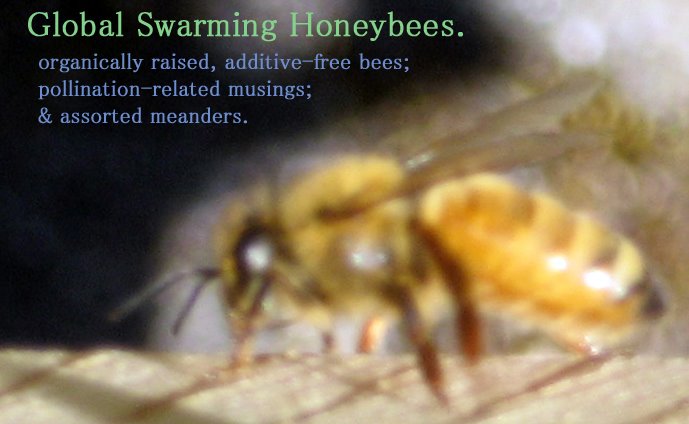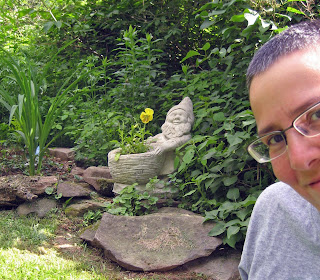The tiny clocks in bees and flowers: read all about it here.
4.29.2009
4.24.2009
Bed Stuy Bees!
Check out these pics of yesterday's daring honeybee rescue adventure in Bedford Stuyvesant, Brooklyn.
Andrew Cote of the New York City Beekeepers Association led the rescue brigade; here's an excerpted version of Andrew's report on the escapade:
Some of you know that we at the New York City Beekeepers Association (www.nyc-bees.org) will do just about anything for honeybees. We received word a couple of days ago that a tree in Brooklyn had fallen, was resting across wires, but the tree men could not remove it since there was a colony of honeybees living within. There was talk of poisoning the hive. So we at the NYCBA sprung into action.
Bob, whose house it is, took lots of pics and put this all up - amazing! The bees are not featured so much since the event went pretty flawlessly. We got there early enough to screen the bees in before their morning flight, and though a little time consuming and nerve wracking to be under the heavy branch near the wires, all worked out well. Not a single bees was harmed, and only two were spotted on the wrong side of the screen.
Those concerned will be happy to know that the log that is the honeybees' home is now upright in the original position, and situated in my front yard in Connecticut. The bees seem none the worse for wear though they did not enjoy being bounced around in the back of the van for a couple of hours.
Wherever danger threatens honeybees, wherever there is pollinating to be done, whenever we are needed, we will be there.
4.20.2009
Urban Beekeeping Explosion
Lots of fun stuff re. urban beekeeping these days. It's clear we're in the midst of a major upsurge in the department of cityfolk-doing-rural-things.
Visit the City Bees blog, where bee-blogger Toni takes us on a tour of the White House bee hives!
Meet the keeper of the Clinton Community Garden beehive in Hell's Kitchen, New York.
Listen to a recent WNYC profile on the NYC Beekeepers Association.
Check out this recent conversation about the value of beekeeping in NYC and the status of the efforts to make it legal with the Executive Director of Just Food and a leading honeybee researcher. (Scroll down until you see "The Buzz Around Town.")
4.19.2009
Spring = Dandelions

Pulling some of my old postcards out to share with ya'll. The dandelion, as it happens, is one of the most important spring forage flowers for the honeybee. It's also the yummiest cooked green around, and yours for the taking. So let's take a moment to celebrate this much maligned yet wondrous plant.
4.17.2009
4.16.2009
4.15.2009
The Silence of the Bees
Just a reminder of what's at stake.
4.13.2009
A History of White House Gardens
Recently we posted an article from the Thrill Dept. about the new vegetable garden and beekeeping scene over on the White House lawn along with a fun video about the history of White House gardens (see below).
Along similar lines, I recently found this nugget of fun on the website of the Brooklyn Botanic Gardens (a truly wonderful place in the Home Borough): First Gardens: An Election Year Primer on the White House Gardens, published last summer. It's well worth reading, and don't miss the part (and the very end) about Ronald Reagan and the sinkhole—priceless and just so achingly metaphoric.
And here's that video I posted last month, in case you missed it:
The Garden of Eatin': A Short History of America's Garden from roger doiron on Vimeo.
4.12.2009
4.10.2009
Sustaining Dialogue on Sustainable Food Systems in NYC
The New York Times has been running a nice series this week wherein the Executive Director of Just Food has been answering readers' questions about all things food-, ag-, and sustainability-related.
I submitted two questions and today, one of my questions (about bees, of course) was answered. Here's the item. Also discussed: community-supported agriculture, food justice, and ferreting out locally grown legumes.
Here is the first set of questions and replies, in which urban chickens, community gardens, and locavore-itude in an urban context are discussed.
Annual Beekeeping Survey—Please Participate
If you're already keeping bees in the U.S., please take a moment to complete this year's survey on how your hives are doing, to enable the Apiary Inspectors of America (AIA) and the United States Department of Agriculture (USDA) to compile a nationwide picture of what the heck is going on with our bees.
The deadline for turning in this simple survey is Friday, April 17th, 2009.
Unfortunately, the survey is not available in an online format (don't ask me why), but you can cut and paste the questions into an email, answer them, and e-mail your responses to: beeloss@gmail.com
According to the PR sent around earlier this week from the folks at Bee Culture:
The information you provide will be entered into a spreadsheet and will not be attached to your name or address in any way. In addition to this e-mail survey, you may be contacted by phone and asked the same questions. Please provide answers to both if you are asked to do so – but mention to the phone interviewer that you have already answered the questions via email.Be sure to send your survey response to the email provided above prior to April 17, 2009. And please feel free to pass this along to your beekeeping buddies—the more beekeepers participate, the more complete a picture can be gathered about what is happening to our honeybees, and why.
The results of this survey will be compiled and published so that everyone can see how bees are doing in the United States. These results, along with those from the past two years, will be used to secure research funding and assistance for Bee health.
The survey questions are as follows:
1. In what state(s) and county(s) do you keep your hives? If you keep hives in more than one state or county, please answer questions 2-9 separately by location.
2. How many hives did you have alive in September 2008?
3. How many hives are alive now (March/April 2009)?
4. How many splits, increases, and/or colonies did you make/buy since September 2008?
5. What percentage of loss, over this time period, would you consider acceptable?
6. What percentage of your hives that died had no dead bees in the hive or in the apiary?
7. To what do you attribute the cause of death for the hives that died?
8. What percentage of your hives did you send to CA for almond pollination?
9. How many times, on average, did you move your colonies last year?
Download the reports from previous years here (winter 06-07) and here (winter 07-08).
4.09.2009
Bees at the White House and in NYC

Two exciting developments had us leaping out of bed and rushing to blog this morning.
The first is this fabulous item on the City Bees blog about the new beehives at the White House. The photos here are borrowed from the blog; you'll definitely want to rush right over to the City Bees page to see more cool pictures ASAP.
The second installment in this morning's Department of Thrills is this friendly article entitled NYC Buzzing With Bees, about the NYC Beekeepers Association, our friends Andrew and Kelly, and the burgeoning interest in urban beekeeping here in our fair city. Check it out.
And while you're at it, do sign up to join the mailing list of the NYC Beekeepers Association to be apprised of the group's upcoming activities.
4.08.2009
Pliny the Fabulous
If you've never had the pleasure of reading or perusing the natural history writings of Pliny the Elder, you're missing out. A friend recently sent this gem along, reminding me of how much I've enjoyed my past excursions with the great naturalist of yore.
"Honey comes out of the air....At early dawn the leaves of trees are found bedewed with honey.... Whether this is the perspiration of the sky or a sort of saliva of the stars, or the moisture of the air purging itself, nevertheless it brings with it the great pleasure of its heavenly nature. It is always of the best quality when it is stored in the best flowers."—Pliny (A.D. 23-79) 'Natural History', book 20Check out Pliny's encyclopedia of natural life, circa AD 77.
View or download Vol. 3 of the Pliny's Natural History here. In this edition, he writes of insects (including bees), with chapter headings such as:
- The extreme smallness of insects
- Happy omens sometimes afforded by a swarm of bees
- The kinds of honey peculiar to various places
4.07.2009
Just Food in the New York Times
Spring is here on so many levels. And a welcomed groundswell of attention is being paid to sustainable farming, community-supported agriculture, urban food-growing, and all that good stuff.
We're pleased to see that the Executive Director of Just Food—a NYC-based organization that, among its many other good works, is seeking to get beekeeping legalized in our fair city—is being featured in one of the New York Times' Q&A columns.
So go ahead, Ask About Local Food in New York!
4.06.2009
Scientific American Article on Honeybees
Here's a relatively new article on the mystery of the vanishing bees. I've not had time to read it yet, but figured I'd share it and see what ya'll think. Drop a comment below.
Urban Beekeeping
Nice article in Scientific American on urban beekeeping, which includes a quote from our friend Andrew of Andrew's Local Honey.
Money Honey Bee
Bothered/bee-wildered by the economic mess, the tsunami of inane financial jargon floating around these days, and the intricacies of the financial sector's hijinks? Then you need to see this. (Besides, it's Monday and we could all use a bitter laugh.)
| The Daily Show With Jon Stewart | M - Th 11p / 10c | |||
| The Money Honey Bee | ||||
| comedycentral.com | ||||
| ||||
4.05.2009
Honeybee Communication
Here's a brief video that breaks down some of the elements of communication that occur when honeybee foragers return to the hive and "dance" to indicate the type, location, and quality of food sources in the field to their sister bees:
Dancin' bees.

